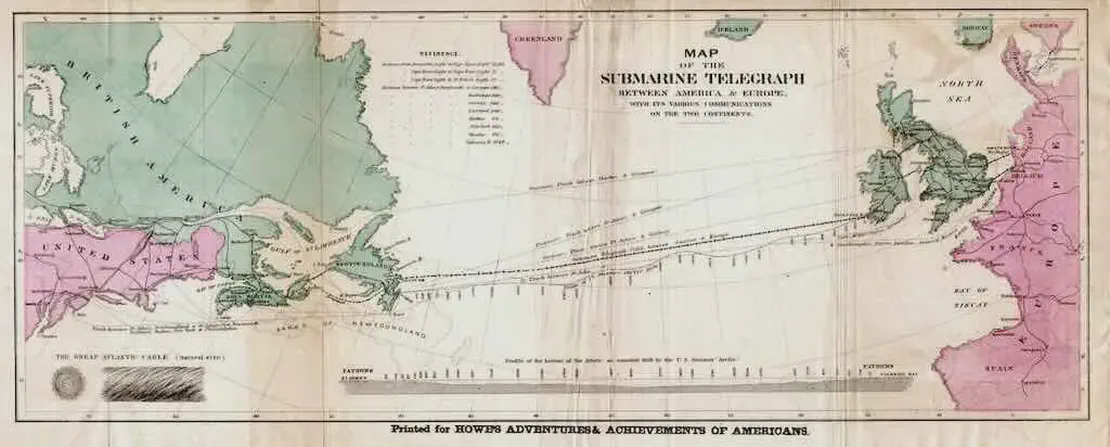On July 27, 1866 in Celtic History
Transatlantic telegraph cable

Transatlantic telegraph cables were undersea cables running under the Atlantic Ocean for telegraph communications. Telegraphy is now an obsolete form of communication and the cables have long since been decommissioned, but telephone and data are still carried on other transatlantic telecommunications cables.
The first cable was laid in the 1850s from Valentia Island off the west coast of Ireland to Bay of Bulls, Trinity Bay, Newfoundland. The first communications occurred on 16 August 1858, but the line speed was poor and efforts to improve it caused the cable to fail after three weeks.
The Atlantic Telegraph Company led by Cyrus West Field constructed the first transatlantic telegraph cable.
The project began in 1854 and was completed in 1858. The cable functioned for only three weeks, but was the first such project to yield practical results. The first official telegram to pass between two continents was a letter of congratulations from Queen Victoria of the United Kingdom to President of the United States James Buchanan on August 16. Signal quality declined rapidly, slowing transmission to an almost unusable speed.
The cable was destroyed the following month when Wildman Whitehouse applied excessive voltage to it while trying to achieve faster operation. It has been argued that the cable’s faulty manufacture, storage and handling would have caused its premature failure in any case.
Its short life undermined public and investor confidence and delayed efforts to restore a connection.
Landing of the Transatlantic telegraph cable of 1866 at Heart’s Content, Newfoundland, by Robert Charles Dudley, 1866 The second cable was laid in 1865 with much-improved material. It was laid from the ship SS Great Eastern, built by John Scott Russell and Isambard Kingdom Brunel and skippered by Sir James Anderson. More than halfway across, the cable broke and after many rescue attempts, it was abandoned.
In July 1866 a third cable was laid from The Anglo-American Cable house on the Telegraph Field, Foilhomurrum. On 13 July, Great Eastern steamed westward to Heart’s Content, Newfoundland, and on July 27 the successful connection was put into service. The 1865 cable was also retrieved and spliced so two cables were in service.
These cables proved more durable. Line speed was very good and the slogan “Two weeks to two minutes” was coined to emphasize the great improvement over ship-borne dispatches. The cable altered for all time personal, commercial and political relations between people across the Atlantic. Since 1866 there has been a permanent cable connection between the continents. In the 1870s duplex and quadruplex transmission and receiving systems were set up that could relay multiple messages over the cable.
Before the first transatlantic cable, communications between Europe and the Americas took place only by ship, and could be delayed for weeks by severe winter storms. By contrast, the transatlantic cable allowed a message and a response in the same day.
Related Content

Shane Patrick Lysaght MacGowan, lead singer of the Pogues, died
Shane Patrick Lysaght MacGowan is an Irish-English musician and songwriter, best known as the lead singer and songwriter of the punk band The Pogues.
Read More
St Machar Day, patron saint of Aberdeen
Saint Machar is the Diocesan Patron Saint of Aberdeen; the Feast Day being observed on 12th November.
Read More
Oíche Shamhna - Cetlic New Year Eve (Halloween)
In Scotland and Ireland, Halloween is known as Oíche Shamhna, while in Wales it is Nos Calan Gaeaf, the eve of the winters calend, or first. With the rise of Christianity, Samhain...
Read More
ALBAN ELFED (Welsh Bardic name for autumn equinox)
Alban Elued, The Light of the Water, the first day of Autumn, was also called Harvesthome. Observed on September 21, the Autumnal Equinox was the day when the sun again began to...
Read More
Feast day of St. James
Guinness St. James Gate Since mediaeval times, Dubliners held an annual drinking festival in the Saint’s honor. Fittingly, Guinness chose St. James’ Gate as the site for their...
Read More
John Davie Burgess, King of the Highland Pipers, died at age 71.
John Burgess died on June 29, 2005 at the age of 71.
Read More
No location specified

No location specified

No location specified

No location specified

No location specified

No location specified

No location specified

No location specified